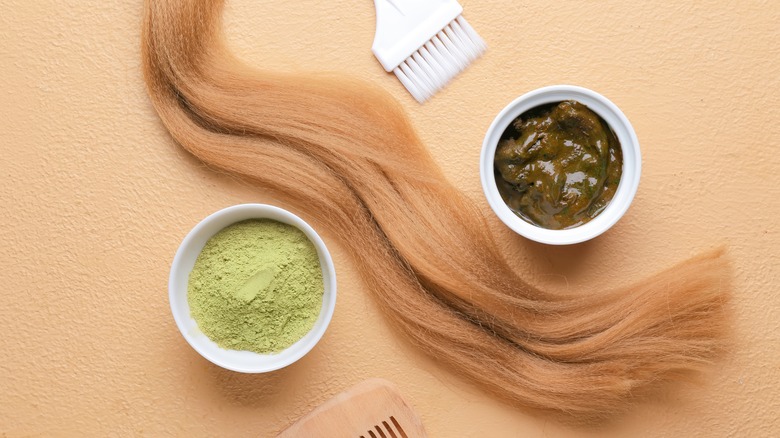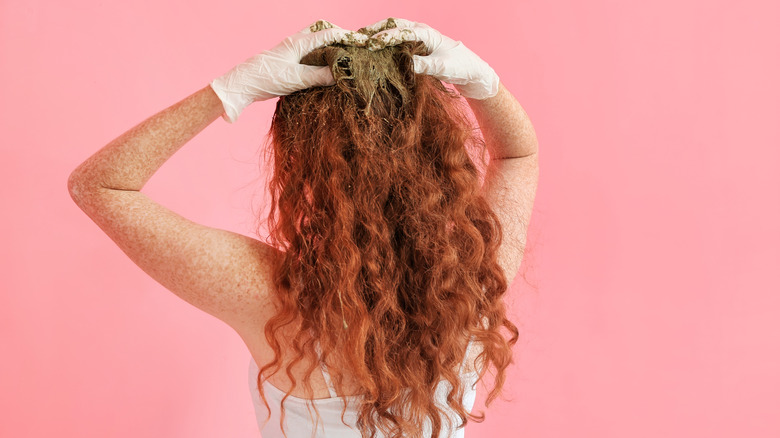Why Your Hair's Porosity Type Is Important When Using Henna Dyes
In recent years, more and more beauty enthusiasts have started incorporating henna into their routines, using it to create tattoo freckles, darken eyebrows, or dye their hair organically. If you're unfamiliar, henna is a plant-based dye that can be used on the hair and skin, per L'officiel. Sometimes called mehndi, henna tattooing is also an art form that involves using the dye to draw intricate, meaningful designs on the body, typically the hands and legs. It's been a staple of many South Asian, Middle Eastern, and African cultures for centuries, dating back to 1,200 B.C. when it was first used in ancient Egypt.
Western culture's modern use of henna as a hair dye can be attributed to the rise in natural and sustainable products (via Its Elixir). Though henna was used as hair dye by Hari Salem in the 1970s, the celebrity hairstylist notes its reemergence in the mainstream alongside the shift to more eco-conscious consumerism, according to Professional Hairdresser Magazine.
If you take an interest in organic products or have simply been looking for an alternative to traditional dye, then you've likely been wondering about using henna on your hair. It's a great natural option that has been used in many cultures for centuries, but there are some things to consider before jumping right in.
Explaining hair porosity
Along with texture and density, porosity is a characteristic of hair that is important to consider when taking care of your tresses. Specifically, this attribute can impact how your hair reacts to henna and other dyes. As defined by Healthline, porosity refers to how well the hair can ingest and sustain moisture. It's dependent on the composition of the outer layer of the hair, which is made up of cuticles that can be flat or raised and sit far or close together.
If you have high porosity hair, then your strands are very porous. This means your locks absorb moisture easily but have a hard time maintaining it. As a result, your hair may absorb products easily but ultimately feel dry and frizzy. YouTuber BiancaReneeToday explains that hair porosity is usually genetic but that heat and chemical damage are known to increase porosity.
Low-porosity hair has difficulty taking in moisture, often taking longer to become saturated by water and more time to dry entirely than other porosity types. BiancaReneeToday mentions that products tend to sit on this hair type, leading to unwanted build-up and even making the hair feel greasy at times.
Medium porosity is typically the desired hair type because it moderately absorbs and retains moisture.
Henna and hair porosity
Knowing what hair porosity is, you might wonder how it relates to henna. One of the most significant ways porosity interacts with dye is by determining how well strands absorb color (via Healthline). Hair that is high in porosity will be able to take in the color from henna most effectively, whereas those with low-porosity locks might see less of an impact from the dye.
Lush co-founder Rowena Bird also told InStyle that porosity influences how long henna will appear on the hair, explaining, "The more porous, the longer it will last, and as it grows out, it will also fade nicely."
Lastly, it's possible that applying henna dye can actually influence hair porosity. Honest Liz points out the potential drying effect the dyeing process might have. This is why the founder of HennaSooq, Khadija Dawn Carryl, emphasizes the importance of balancing henna treatments with moisturizing efforts to prevent hair from drying out. Knowing your porosity will help you do this effectively.


